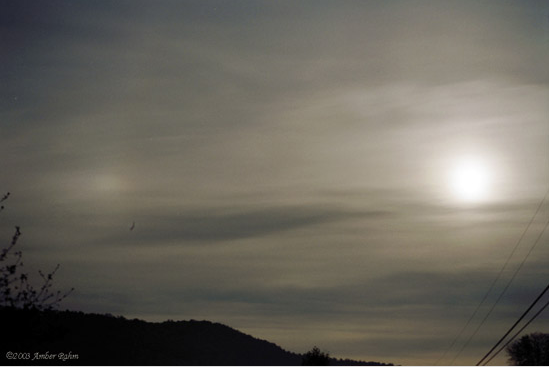Moon dogs - paraselene
Moon Dogs - Paraselene: A Spectacular Atmospheric Phenomenon
Moon dogs, also known as paraselene, are a captivating atmospheric phenomenon that often leave observers in awe. These stunning optical illusions create the illusion of two bright spots of light on either side of the moon, resembling a pair of "dogs" accompanying our celestial neighbor. While they may appear mysterious and otherworldly, moon dogs have a scientific explanation rooted in the principles of atmospheric optics.
The Science Behind Moon Dogs
Moon dogs are a type of atmospheric optical phenomenon called a parhelion. Parhelia occur when light from the sun or moon is refracted by ice crystals in the atmosphere, such as those found in high-altitude cirrus clouds. These ice crystals act like tiny prisms, bending and dispersing the light into its component colors.
When the light passes through these ice crystals at a specific angle, it creates a ring of light around the sun or moon known as a halo. Moon dogs are formed when the light passing through the ice crystals is refracted and reflected at an angle of 22 degrees, resulting in two bright spots of light appearing on either side of the moon.
The Appearance of Moon Dogs
Moon dogs typically appear as bright spots of light with a whitish or pale coloration. However, under certain atmospheric conditions, they can exhibit faint colors, adding to their enchanting beauty. These colors are caused by the dispersion of light as it passes through the ice crystals, similar to how a prism separates white light into a spectrum of colors.
The size and intensity of moon dogs can vary depending on several factors, including the size and shape of the ice crystals and the angle at which they are aligned. In some cases, moon dogs may appear as distinct and well-defined spots, while in others, they may be more diffuse and less pronounced.
The Connection to Halo Phenomena
Moon dogs are closely related to other halo phenomena, such as the 22° circular halo mentioned in the original content. This circular halo is caused by the refraction and reflection of light within the ice crystals at a specific angle of 22 degrees. Moon dogs, on the other hand, occur when this same angle is applied to the light passing through the ice crystals.
The combination of a circular halo and moon dogs can create a mesmerizing spectacle in the night sky. When both phenomena are present, observers may witness a ring of light encircling the moon, with two bright spots on either side, resembling a celestial trio.
The Role of Weather Conditions
Weather conditions play a crucial role in the formation and visibility of moon dogs. These atmospheric phenomena are more commonly observed in colder regions where ice crystals are more abundant, such as polar regions or during winter months. Additionally, moon dogs are more likely to be seen when there is a thin layer of high-altitude cirrus clouds present in the sky.
To increase the chances of spotting moon dogs, it is best to look for them during clear nights when the moon is relatively high in the sky. Light pollution can hinder their visibility, so finding a location away from city lights will provide optimal viewing conditions.
Cultural Significance
Throughout history, moon dogs have captivated and inspired people across various cultures. In folklore and mythology, these phenomena have been interpreted as omens or signs of impending change or celestial events. They have been associated with mystical or supernatural occurrences, fueling the imaginations of storytellers and poets.
Moon dogs also hold cultural significance in some indigenous communities. For example, the Inuit people of the Arctic have traditionally believed that moon dogs are spirits guiding travelers on their journeys through the vast frozen landscapes.
Capturing Moon Dogs on Camera
Photographing moon dogs can be a rewarding experience for both amateur and professional photographers. To capture these elusive phenomena, it is recommended to use a camera with manual settings and a tripod to ensure stability. Increasing the exposure time can help capture the faint colors and details of moon dogs.
Experimenting with different camera lenses and filters can also enhance the visibility and vibrancy of moon dogs in photographs. However, it is important to remember that moon dogs are relatively rare and require specific atmospheric conditions to occur, so patience and persistence are key when attempting to photograph them.
Conclusion
Moon dogs, or paraselene, are a remarkable atmospheric phenomenon that continues to fascinate observers worldwide. Understanding the science behind these optical illusions adds a sense of wonder to their appearance. Whether they are seen as celestial companions or mystical guides, moon dogs remind us of the beauty and complexity of the natural world that surrounds us. So, next time you find yourself gazing at the moonlit sky, keep an eye out for these enchanting spectacles and allow yourself to be transported into a world of atmospheric wonders.

Moon Dog, Vermont. Taken by Amber Rahm 26th May '02 with a 35mm lens on Kodak Max 800. The moon dog shows slight colours and there is a faint 22° circular halo. ©2002 Amber Rahm, shown with permission.
Note: this article has been automatically converted from the old site and may not appear as intended. You can find the original article here.
Reference Atmospheric Optics
If you use any of the definitions, information, or data presented on Atmospheric Optics, please copy the link or reference below to properly credit us as the reference source. Thank you!
-
<a href="https://atoptics.co.uk/blog/moon-dogs-paraselene/">Moon dogs - paraselene</a>
-
"Moon dogs - paraselene". Atmospheric Optics. Accessed on April 23, 2024. https://atoptics.co.uk/blog/moon-dogs-paraselene/.
-
"Moon dogs - paraselene". Atmospheric Optics, https://atoptics.co.uk/blog/moon-dogs-paraselene/. Accessed 23 April, 2024
-
Moon dogs - paraselene. Atmospheric Optics. Retrieved from https://atoptics.co.uk/blog/moon-dogs-paraselene/.